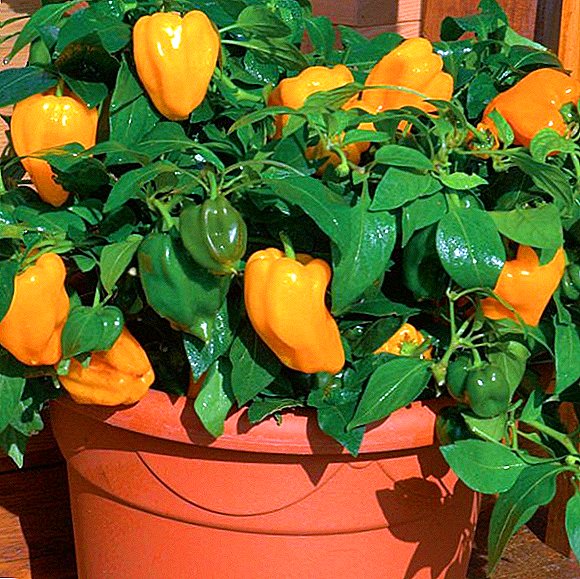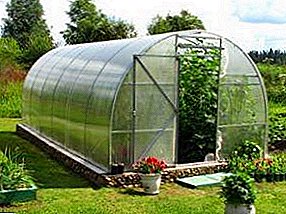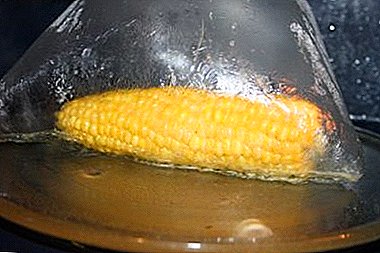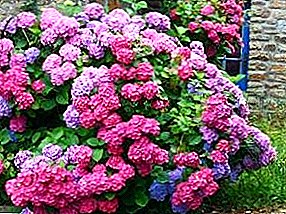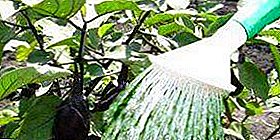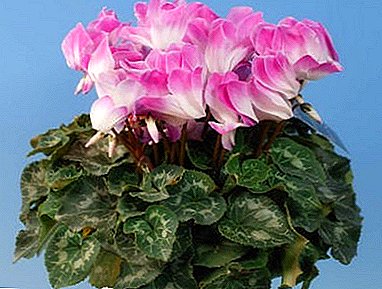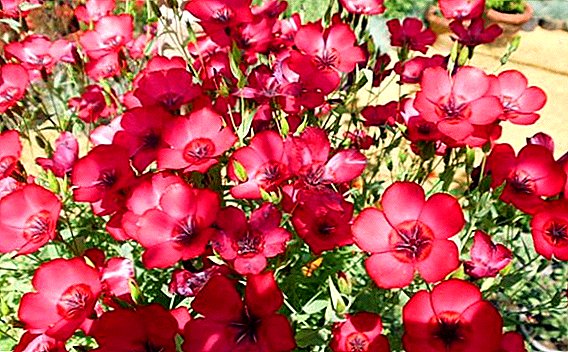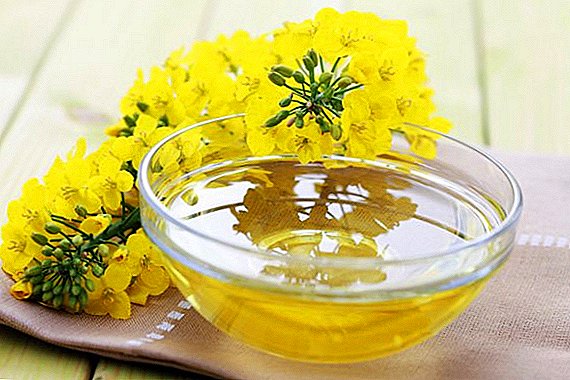
Among the many varieties of white cabbage variety Kolobok enjoys well-deserved popularity.
It is grown not only in vegetable gardens and suburban areas, but also on an industrial scale. And there are valid reasons for this.
In order for cabbage of this variety not to disappoint the harvest, it is necessary to have an idea about its features, requirements for agricultural technology and soil and other necessary conditions.
Characteristic view with a photo
Kolobok f1 - a hybrid variety of medium maturity. Technical ripeness of the vegetable occurs in 115-120 days after transplanting. The leaves are dark green, whitish on the inner surface. The form is obovoid, the surface is smooth, with a slight wax coating, streaks of medium thickness.
The rosette of leaves forms a large, raised, about 35 cm tall. Heads of cabbage are formed dense, rounded in shape, weighing 4-5 kg. Kocheriga inside is small.
The diameter of the plug in the period of technical maturity is about 50 cm.
Used for fresh consumption and the preparation of various dishes for all kinds of pickling and pickling. Besides, Gingerbread man can be stored fresh for a long time.without changing the taste.



History of
The variety Kolobok was bred by the Moscow N. N. Timofeev Breeding Station. In the State Register of the Russian Federation was included in 1994. Since 1997, it has been widely distributed not only in Russia, but also in the near abroad: in Ukraine, in Belarus, etc.
What is the difference from other hybrids?
The grade difference is universality in use. Excellent taste makes it suitable for wide use in cooking.
In the description of the variety Kolobok, cabbage immunity to many diseases is always noted, which makes it possible to grow without the use of chemicals. Under the conditions of cultivation, the variety gives a stable yield.regardless of region.
Proof of how well a variety is stored can be obtained from the video:
Advantages and disadvantages
The main advantages of this variety:
- good taste, no bitterness;
- resistance to cracking heads;
- long shelf life;
- the presentation is not lost during transportation;
- resistance to major diseases;
- universality of use;
- suitable for growing in almost any region.
The disadvantages of the Kolobok variety include:
- demanding watering;
- the need for fertile soil;
- high light-loving.
Step by Step Growing Instructions
Where can I get seeds?
 You can buy seeds of Kolobok variety in a specialty store or department. Besides, There are many online stores that will provide home delivery. It is better to purchase seeds of famous brands, for example, Aelita, SeDek, Gavrish and others. This will give a guarantee of quality seed.
You can buy seeds of Kolobok variety in a specialty store or department. Besides, There are many online stores that will provide home delivery. It is better to purchase seeds of famous brands, for example, Aelita, SeDek, Gavrish and others. This will give a guarantee of quality seed.
The cost of the bag will be from 25-30 rubles and more, depending on the brand of the manufacturer and the number of seeds.
Sowing time
You can grow cabbage seedlings and seeds. Sowing seeds immediately into the ground should occur in the heated soil, so this method is only suitable for the southern regions. For seedlings, seeds are sown in early April. Transplantation into the ground occurs from mid-May, after the formation of 5-6 leaflets.
Choosing a place
For the cultivation of cabbage should observe crop rotation. The site where they used to grow cucumbers, legumes, onions or potatoes would be suitable.
The beds from under the tomatoes, radishes or beets are not recommended, because these cultures share pests and diseases with cabbage.
A sufficient amount of light should fall on the plot; on a shaded place, this variety will not produce a decent crop.
What should be the soil?
The soil should be quite fertile, loamy.. Plant development slows down in oxidized soil. Land is desirable to cook in the fall. Lime fertilizers are applied to the site: chalk, hydrated lime, wood ash, etc. In the spring, organic fertilizers are added, and a mixture of wood ash, superphosphate and urea is placed in each well when planting seedlings.
For planting seeds use the mixture for seedlings. Or independently mix garden soil with humus and peat. Before sowing, the soil should be treated with boiling water with potassium permanganate to protect the seedlings from the black leg.
Landing
Planting seeds is carried out no deeper than 1 cm. After the appearance of two true leaves, the cabbage should be dived, the distance between the seedlings is 5-6 cm. When planting seedlings, observe the distance between the holes 60x70 cm Pour a liter of water into the hole, fill the seedling with earth to the bottom leaf. The first days after planting the seedlings need shading.
Temperature
When planting seedlings in the ground it is important that the air temperature was at least 12-15 degrees. With daily rates of + 20 and above, the seedlings need to be further shaded, and monitor the level of soil moisture.
Night temperature fall should be no more than - 5. At lower rates, cover the film at night. The ideal temperature for Kolobok is +18 during the day and +8 at night.
Watering
 Gingerbread man demanding watering. After transplantation during the week, it should be done 2-3 times a day. In the future, the number of irrigations gradually reduced to 1-2 times a week, provided that the earth remains wet. 10 days before cleaning, watering is stopped.
Gingerbread man demanding watering. After transplantation during the week, it should be done 2-3 times a day. In the future, the number of irrigations gradually reduced to 1-2 times a week, provided that the earth remains wet. 10 days before cleaning, watering is stopped.
Planted seedlings watered at the root, then do it along the grooves. After heading, water should be poured from above directly onto the leaves.so pests and their larvae are washed away. Water consumption for irrigation an average of 10 liters per 1 m2.
Top dressing
Fertilizers for this variety are made 3-4 times per season. The first feeding is carried out in 2-3 weeks after planting seedlings, then after another 10 days. For fertilizers use organic and mineral substances. During the period of enhanced leaf growth, nitrogen supplements are necessary.
The last nutrient intake is made about three weeks before the harvest, and since the heading is formed at this time, they must be potash-nitrogenous.
Other Vegetable Care Tips
In order to prevent fungal diseases, it is necessary to loosen after each watering. Besides, cabbage bushes need hilling. The first time it should be done in three weeks after disembarkation, in the future - every 10 days.
Harvesting
When the cabbages feel tight and the weight increases, the harvest is ripe for harvesting. It can also be identified by lower leaves that begin to turn yellow. Variety Kolobok can be cleaned either by machine or manually. First, remove the lower leaves, then cut the head itself. This should be done in dry weather, before the onset of frost.
Storage of heads
This grade is used for all types of preparations. Cabbage marinated, salted, pickled or stored fresh. To do this, use the premises, the temperature in which from 0 to +3 degrees. Humidity level should be 90-98%.
Forks are placed on the shelves, leaving space between them, suspended upward by the stalk or placed in boxes. To ensure that the upper leaves do not dry out or become flabby, you can keep the cabbages shook in the plastic wrap.
Diseases and pests
This variety is resistant to major diseases of the species.:
 gray and white rot;
gray and white rot;- Fusarium;
- bacterial, fungal and viral infections.
Gingerbread man can hit slugs. They are harvested by hand, sprinkled with lime to fight them. To prevent damage, mulch the soil around the plants..
A possible pest may be a cabbage fly. To combat it, use pollination tobacco dust or wood ash.
Preventive measures
Observing the basic rules of agricultural engineering, should pay attention to some points:
- Do not over-wet the soil.
- Tillage after each watering.
- Do not plant seedlings too early, before the cold weather recedes.
- Observe the distance between the bushes when disembarking.
- Spud in a timely manner.
Gingerbread Man - Universal Grade, which can be grown on the summer cottage or garden, and on the farmers' fields. Caring for him is simple, yields are high even in cold regions. It has excellent taste, which does not lose even with long-term storage.


 gray and white rot;
gray and white rot;
